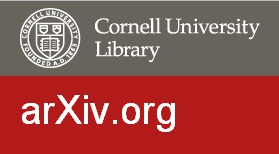Marek Kwiek and Wojciech Roszka published a new preprint of their research:
“Gender-Based Homophily in Research: A Large-Scale Study of Man-Woman Collaboration”
See link here.
Abstract
This paper investigates the respective impacts of (1) biological age, (2) academic position, (3) academic discipline, (4) journal prestige, and (5) type of institution of employment on the propensity to conduct same-sex collaboration in research. The gender homophily principle was found to work for male scientists – but not for females. The majority of male scientists collaborate solely with males; most female scientists, in contrast, do not collaborate with females at all. The propensity for same-sex collaboration of males is three times that of females. Across all age cohorts, scientists of both genders tend to collaborate more with males. All-female collaboration is marginal, while all-male collaboration is pervasive. However, a year-by-year approach confirmed a downward trend in same-sex collaboration among males and an upward trend among females. Additionally, gender homophily in research-intensive institutions proved stronger for males than for females. Finally, we estimated odds ratios of high homophily in publishing and used linear regression to explain the variability of the same-sex collaboration ratio in publishing. A comprehensive, fully integrated, biographical, administrative, publication, and citation database was used, and our sample (N = 25,463) included all Polish professors employed in 85 research-involved universities, grouped into 27 disciplines, with all their Scopus-indexed 2009-2018 publications (158,743 articles).
Highlights
- We examined male-female collaboration practices of all internationally productive (25,000) Polish university professors based on their 160,000 Scopus-indexed publications.
- We merged a national registry of 100,000 scientists (with full administrative and biographical data) with the Scopus publication database.
- We examined the propensity to conduct same-sex collaboration across male-dominated, female-dominated, and gender-balanced disciplines.
- Across all age-cohorts and all academic positions, the majority of male scientists collaborate solely with males, and the majority of female scientists, in contrast, do not collaborate with females.
- The gender homophily principle (publishing predominantly with scientists of the same sex) works powerfully for male scientists but does not seem to work for female scientists.
- Articles written in mixed-sex collaboration are, on average, published in more prestigious journals than are those written in same-sex collaboration.
- Logistic regression analysis shows that the propensity to conduct same-sex collaboration for males is more than three times that for females.
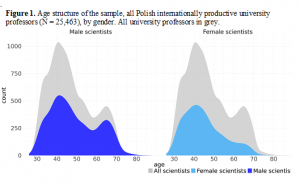
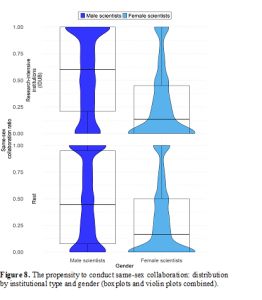

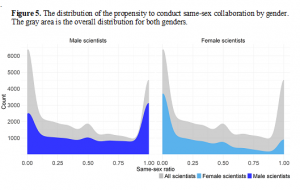
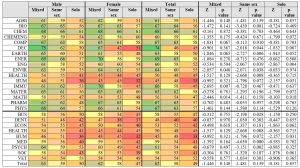
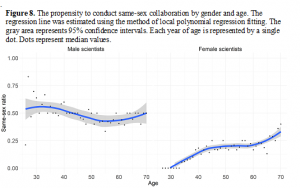
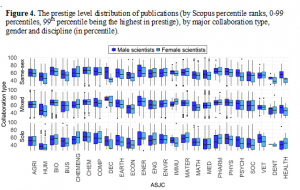
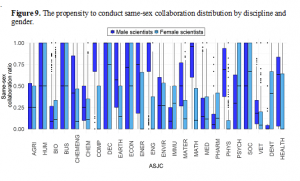
References
Abramo, G., D’Angelo, C. A., & Rosati, F. (2015). Selection committees for academic recruitment: Does gender matter? Res. Eval., 24(4), 392–404.
Abramo, G., Aksnes, D. W., & D’Angelo, C. A. (2020). Comparison of research productivity of Italian and Norwegian professors and universities. J. Informetr., 14(2), 101023.
Aksnes, D. W., Rørstad, K., Piro, F. N., & Sivertsen, G. (2011). Are female researchers less cited? A large scale study of Norwegian researchers. J. Am. Soc. Inf. Sci. Tech., 62(4), 628–636.
Aksnes, D. W., Piro, F. N., & Rørstad, K. (2019) Gender gaps in international research collaboration: A bibliometric approach. Scientometrics. 120, 747–774.
Boschini, A., & Sjögren, A. (2007) Is team formation gender neutral? Evidence from coauthorship patterns. J. Labor Econ., 25(2), 325–365.
Campbell, L. G., Mehtani, S., Dozier, M. E., & Rinehart, J. (2013). Gender-heterogeneous working groups produce higher quality science. PLOS ONE, 8(10), e79147.
Diezmann, C., & Grieshaber, S. (2019). Women professors. Who makes it and how? Singapore: Springer Nature.
Enamorado, T., Fifield, B., & Imai, K. (2019). Using a probabilistic model to assist merging of large-scale administrative records. Am. Political Sci. Rev., 113(2), 353–371.
Fell, C. B., & König, C. J. (2016). Is there a gender difference in scientific collaboration? A scientometric examination of co-authorships among industrial-organizational psychologists. Scientometrics, 108(1), 113–141.
Fellegi, I. P., & Sunter, A. B. (1969). A theory for record linkage. J. Am. Stat. Assoc., 64, 1183–1210.
Ghiasi, G, Mongeon, P., Sugimoto, C., & Larivière, V. (2018). Gender homophily in citations. In 3rd International Conference on Science and Technology Indicators (STI 2018) (pp. 1519–1525).
Ghiasi, G., Larivière, V., & Sugimoto, C. R. (2015). On the compliance of women engineers with a gendered scientific system. PLOS ONE, 10(12).
Halevi, G. (2019). Bibliometric studies on gender disparities in science. In W. Glänzel, H. F. Moed, U. Schmoch, & M. Thelwall (Eds.), Springer handbook of science and technology indicators (pp 563–580). Cham: Springer.
Herzog T. N., Scheuren F. J., & Winkler W. E. (2007) Data quality and record linkage techniques. Dordrecht: Springer.
Huang, J., Gates, A. J., Sinatra, R., & Barabási, A.-L. (2020). Historical comparison of gender inequality in scientific careers across countries and disciplines. Proc. Natl. Acad. Sci. U.S.A., 117(9), 4609–4616.
Jadidi, M., Karimi, F., Lietz, H., & Wagner, C. (2018) Gender disparities in science? Dropout, productivity, collaborations, and success of male and female computer scientists. Adv. Complex Syst., 21(3–4), 1750011.
Jaro, M. A. (1989) Advances in record linkage methodology as applied to the 1985 census of Tampa Florida. J. Am. Stat. Assoc., 84(406), 414–420.
King, M. M., Bergstrom, C. T., Correll, S. J., Jacquet, J., & West, J. D. (2017). Men set their own cites high: Gender and self-citation across fields and over time. Socius, 3.
Kwiek, M. (2016). The European research elite: A cross-national study of highly productive academics across 11 European systems. Higher Education, 71(3), 379-397.
Kwiek, M. (2018a). Academic top earners. Research productivity, prestige generation and salary patterns in European universities. Science and Public Policy. 45(1). February 2018. 1–13.
Kwiek, M. (2018b). High Research Productivity in Vertically Undifferentiated Higher Education Systems: Who Are the Top Performers?. Scientometrics. 115(1). 415–462.
Kwiek, M. (2019). Changing European Academics. A Comparative Study of Social Stratification, Work Patterns and Research Productivity. London and New York: Routledge.
Kwiek, M. (2020a). What Large-Scale Publication and Citation Data Tell Us About International Research Collaboration in Europe: Changing National Patterns in Global Contexts. Studies in Higher Education. Vol. 45. On-line first April 10, 2020. 1-21.
Kwiek, M. (2020b). Internationalists and Locals: International Research Collaboration in a Resource-Poor System. Scientometrics. Vol. 125. On-line first April 28, 2020
Kwiek, M., Roszka, W. (2020). Gender Disparities in International Research Collaboration: A Large-Scale Bibliometric Study of 25,000 University Professors (under reviews in Journal of Economic Surveys).
Larivière, V., Sugimoto, C. R., Chaoquin, N., Gingras, Y., & Cronin, B. (2013). Global gender disparities in science. Nature, 504, 211–213.
Larivière V., & Gingras Y. (2010). The impact factor’s Matthew effect. A natural experiment in bibliometrics. J. Am. Soc. Inf. Sci. Tech., 61(2), 424–427.
Maddi, A., Larivière, V., & Gingras, Y. (2019). Man-woman collaboration behaviors and scientific visibility: Does gender affect the academic impact in economics and management? Proceedings of the 17th International Conference on Scientometrics & Informetrics (pp. 1687–1697). September 2–5, 2019.
Madison, G., & Fahlman, P. (2020). Sex differences in the number of scientific publications and citations when attaining the rank of professor in Sweden. Stud. High. Educ., 1–22. doi:10.1080/03075079.2020.1723533.
McDowell, J. M., Larry, D., Singell, Jr., & Stater, M. (2006) Two to tango? Gender differences in the decisions to publish and coauthor. Econ. Inq., 44(1), 153–168.
McPherson, M., Smith-Lovin, L., and Cool, J. M. (2001). Birds of a feather: Homophily in social networks. Annu. Rev. Sociol., 27, 415–444.
Mihaljević-Brandt, H., Santamaría, L., & Tullney, M. (2016). The effect of gender in the publication patterns in mathematics. PLOS ONE, 11(10), e0165367.
Nielsen, M. W. (2016) Gender inequality and research performance: Moving beyond individual-meritocratic explanations of academic advancement. Stud. High. Educ., 41(11), 2044–2060.
Potthoff, M., & Zimmermann, F. (2017). Is there a gender-based fragmentation of communication science? An investigation of the reasons for the apparent gender homophily in citations. Scientometrics, 112(2), 1047–1063.
Sarsons, H., Gërxhani, K., Reuben, E., and Schram, A. (2020). Gender differences in recognition for group work. Forthcoming in the J. Political Econ.
Sivertsen, G. (2019). Developing Current Research Information Systems (CRIS) as Data Sources for Studies of Research In W. Glänzel, H. F. Moed, U. Schmoch, & M. Thelwall (Eds.), Springer handbook of science and technology indicators (pp 667–683). Cham: Springer.
Topaz, C. M., & Sen, S. (2016). Gender representation on journal editorial boards in the mathematical sciences. PLOS ONE, 11(8), e0161357.
Van Emmerik, I. H. (2006). Gender differences in the creation of different types of social capital: A multilevel study, Soc. Netw., 28(1), 24–37.
Van den Besselaar, P., & Sandström, U. (2016). Gender differences in research performance and its impact on careers: A longitudinal case study. Scientometrics, 106(1), 143–162.
Van den Besselaar, P., & Sandström, U. (2015). Early career grants, performance, and careers: A study on predictive validity of grant decisions. J. Informetr., 9(4), 826–838.
Wang, Y. S., Lee, C. J., West, J. D., Bergstrom, C. T., & Erosheva, E. A. (2019). Gender-based homophily in collaborations across a heterogeneous scholarly landscape. ArXiv:1909.01284 [Stat]. http://arxiv.org/abs/1909.01284
Winkler W. (1990) String comparator metrics and enhanced decision rules in the Fellegi-Sunter model of record linkage. Proceedings of the Section on Survey Research Methods, American Statistical Association (pp. 354–359).
Xie, Y., & Shauman, K. A. (2003). Women in science. Career processes and outcomes. Cambridge, MA: Harvard University Press.
Zippel, K. (2017). Women in global science. Stanford: Stanford University Press.
